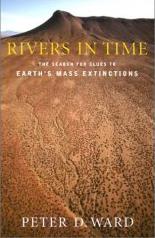
Rivers in Time
Peter D. Ward
315 pages including index
published in 2000
Rivers of Time is a new edition of The End of Evolution, a book originally published in 1994, roughly around the same time as E. O. Wilson's Diversity of Life, with which it overlaps to some point. Like that book, Rivers of Time mixes exploration of the Earth's evolutionary past with concern for the present, focussing on the historical three mega extinctions as well as the one currently under way. Unlike E. O. Wilson's book however, this is not a call to arms. Ward is much more resigned to the great extinction than Wilson is.
Partially this may be because in Ward's view, this great extinction has already happened, with the disappearance of the megafauna of Europe, North America, Australia and many parts of Asia and Africa during the last 15,000-20,000 years, coinciding with the rise of modern humanity. The extinctions still taking place now are just the aftermath of this. I'm not sure how much I agree with this, but at the very least it puts the current destruction of ecosystems in place like Brazil or Borneo into a new perspective, when you realise the same thing had already happened in Europe thousands of years ago.
Rivers of Time is divided into four parts, the first three of which deal with one of the three historical mass extinction events, while the fourth part deals with the modern, ongoing mass extinction. Each of the historical sections outlines the world before the extinctions, what happened during them and how the world was changed by them, as well as some of the history surrounding the discovery of these extinctions. Due to the limited space available, none of this is done in any great detail, just enough to give you an impression.
As said, Rivers of Time focuses on the biggest three historical extinction events, extinctions which reset the clock of evolution so to speak. There also have been a score of lesser events, but these did not have the same worldchanging impact. There have also been two other, older big extinction events but Ward does not mention them. The events he treats are, in order, the Permian/Triassic Event of 215 million years ago, followed by the Triassic/Jurassic Event of 200 million years ago and finally, the Cretaceous/Tertiary event, 65 million years ago which heralded the end of the dinosaurs.
Each event, in its own way, paved the way for our own world to happen, with of course the dinosaurs going extinct (well, except for the birds) being the deciding factor. That is however less interesting than the intriguing idea that species diversity went up after each extinction. More and more evolutionary niches over time were either created or filled and so over millions of years evolutionary diversity kept rising --until now.
With the modern, ongoing extinction, Ward argues that perhaps evolution has ended, or at least that the dramatic recoveries of past events will not be repeated. This because this event's onset has been incredibly fast, giving little time for species to adapt, while biodiversity is at its highest so the damage done is also incredibly high, higher than in previous events. Finally, again unlike previous events, this time a lot of plant species are made extinct as well. Apart from these factors making this extinction more serious, if we manage to reverse it, humanity will still act as a brake on evolution, simply because we wouldn't allow certain classes of (large) animal to evolve, or even allow certain other species we've grown sentimentally attached to, to go extinct.
In all, Rivers of Time was an interesting read, but told me little that I didn't already knew. Both for its handling of biodiversity as well as the ongoing threat to it, E. O. Wilson's Diversity of Life is much better.
Read more about:
Peter D. Ward,
Rivers in Time,
paleontology,
biology,
book review